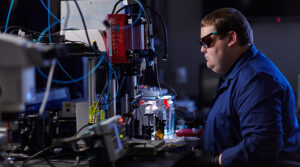Biomedical Engineering Program Receives Significant Stamp of Approval
Students and alumni of Duquesne’s Biomedical Engineering (BME) program already know the high quality of their training and education. Now an international commission has confirmed it.
 The Biomedical Engineering Bachelor of Science program has been accredited by the Engineering Accreditation Commission of the Accreditation Board for Engineering and Technology (ABET), the global accreditor of college and university programs in applied and natural science, computing, engineering and engineering technology.
The Biomedical Engineering Bachelor of Science program has been accredited by the Engineering Accreditation Commission of the Accreditation Board for Engineering and Technology (ABET), the global accreditor of college and university programs in applied and natural science, computing, engineering and engineering technology.
ABET accreditation assures that programs meet standards to produce graduates ready to enter critical technical fields that are leading the way in innovation and emerging technologies while anticipating the welfare and safety needs of the public.
“We are very pleased to receive this stamp of approval from ABET,” said Dr. John Viator, department chair and professor of the school’s Department of Engineering. “We have been working toward this accreditation as it provides our students and alumni with a significant advantage as they pursue their career goals.”
ABET or a similar accreditation is a requirement to receive licensure in most states. A non-profit, non-governmental organization, ABET currently accredits more than 4,300 programs at 846 colleges and universities in 41 countries and areas.
“I congratulate our Department of Engineering on this terrific accomplishment,” said Dr. Fevzi Akinci, dean of Duquesne’s Rangos School of Health Sciences. “The hard work of our faculty and staff to achieve ABET accreditation exemplifies their commitment to offering students a horizon-expanding education.”
The ABET recognition reflects Duquesne’s commitment to preparing students for any challenge by offering innovative opportunities for creativity and problem solving. In 2018, NASA recognized the University’s BME students for creating a zip-tie cutter that could be used in microgravity. In 2019, the department’s BME students reached the finals of a NASA competition where they developed the technical details needed to identify the location of radiation in the atmosphere and determine ways to combat it to safely land astronauts on Mars.
